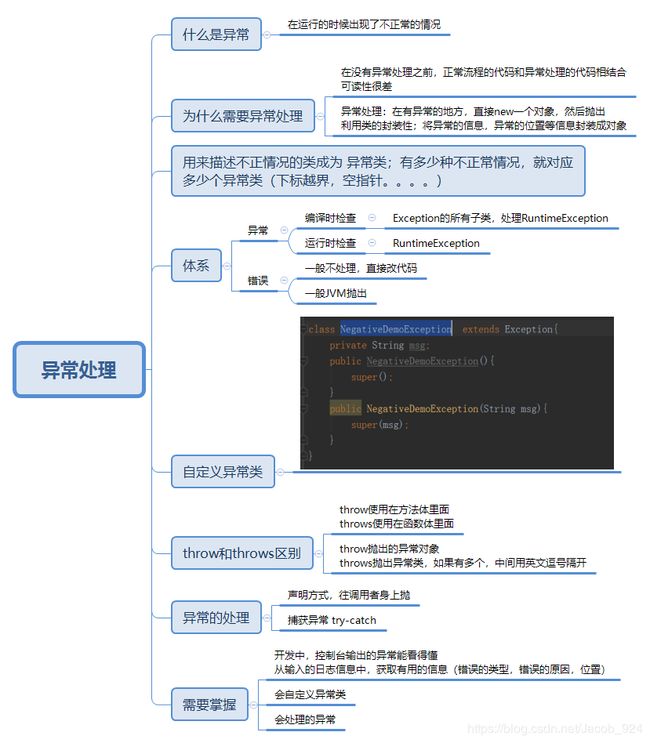java中的异常
Throwable 类是 Java 语言中所有错误或异常的超类。只有当对象是此类(或其子类之一)的实例时,才能通过 Java 虚拟机或者 Java throw 语句抛出。类似地,只有此类或其子类之一才可以是 catch 子句中的参数类型。
Throwable的两个子类Error和Exception
异常:
1.编译时不被检测异常:Error和RuntimeException
这种异常一旦出现,无法继续功能,一般不做处理,产生的原因一般是调用者导致的
(编译可以通过,运行时产生异常)
刚开始没有异常这个类的时候,异常需要自己去解决,自己去做判断
public class Demo {
public int method(int arr[],int index){
if (arr == null){
System.out.println("空指针");
return -1;
}
if (index>=arr.length){
System.out.println("数组下标越界");
return -2;
}
if (index<0){
System.out.println("下标越界");
return -3;
}
return arr[index];
}出现RuntimeException类型的一些异常(子类)的时候,如果在函数体内throw(返回)出该异常,函数名上可以不声明,编译可通过。即使是在函数名上声明了该异常,调用者可以不进行处理,编译也可以通过。之所以不在函数上声明,是不希望调用者处理,因为处理不了,只有把程序停掉,对代码进行修正。
public class Demo {
public int method(int arr[],int index){
if (arr == null){
throw new NullPointerException("数组为NULL");
}
if (index>=arr.length){
throw new ArrayIndexOutOfBoundsException("数组下标越界!!");
}
if (index<0){
throw new FuShuIndex("下标是负数了");
}
return arr[index];
}
//自己定义的异常,继承RuntimeException,也可以加入异常体系
class FuShuIndex extends RuntimeException{
public FuShuIndex() {
}
public FuShuIndex(String s) {
super(s);
}
}
public static void main(String[] args) {
Demo d = new Demo();
int a[] = new int[5];
System.out.println( d.method(a,-1));
System.out.println(d.method(a, 5));
}
}有些异常在RuntimeException的子类中没有,需要自己定义,先继承RuntimeException类,然后再定义空的构造函数,然后再定义一个带有字符串参数的构造函数, 用指定的详细消息构造一个新的运行时异常。
2.编译时被检测异常:Exception下所有的子类,除了特殊的RuntimeException;
这种异常的出现,在编译时就被检测到,这种异常有针对性的处理方式(编译时无法通过)
public class Demo1 {
public int method(int arr[],int index)throws FuShuIndex{ //声明异常
if (index<0){
throw new FuShuIndex("下标是负数了");
}
return arr[index];
}
//自己定义的异常,继承Exception,也可以加入异常体系
class FuShuIndex extends Exception{
public FuShuIndex() {
}
public FuShuIndex(String s) {
super(s);
}
}
public static void main(String[] args) {
Demo1 d = new Demo1();
int a[] = new int[5];
try {
System.out.println(d.method(a, 4));
} catch (Demo1.FuShuIndex fuShuIndex) {
fuShuIndex.printStackTrace();
}
}
}当函数体内throw了一个Exception类型的异常,而函数名上并没有声明该异常告诉上层调用者,那么javac 编译器就认为这个代码是有安全隐患的,不允许编译通过,但如果你声明(throws)了这个异常,上层调用者就可以处理该异常,捕获或者抛出。
IO异常
public class FileReaderDemo {
public static void main(String[] args) {
FileReader reader = null;//创建输入流对象,与文件建立绑定
try {
reader = new FileReader("D://text.txt");
} catch (FileNotFoundException e) { //文件找不到异常
System.out.println("文件找不到");
/* e.printStackTrace();*/
}
int i = 0;
try {
if (reader!=null){
while ((i=reader.read()) != -1){//调用读的方法,返回读取的字符
System.out.print((char)i);
}
}
} catch (IOException e) {
/*e.printStackTrace();*/
System.out.println(e.getMessage());//得到异常的详细信息
}
try {
if (reader != null){
reader.close();//关闭资源
}
} catch (IOException e){ //io异常
e.printStackTrace();
}
}
}
